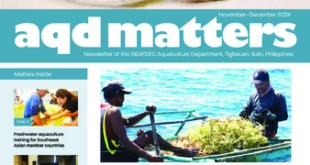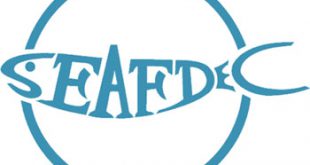 Technology Description
Technology Description
Brief description: Seabass is a species that is easy to culture in cages or in brackishwater ponds. It is hardy, and the seedstock can be easily sourced from the hatchery. There is a need, however, to include a nursery before the grow-out phase so that seabass can be easily sorted and size-graded to reduce competition for space and food, thus controlling cannibalism. Survival in the 30-45 day nursery phase can be as high as 96%.
The biggest expense for seabass culture is feeds, as the fish is carnivorous and must be fed trash fish. But there are already available high-protein formulated feeds that can be used like SEAFDEC/AQD’s formulation for carnivorous species. And, other than the regular sorting and size-grading, seabass culture is pretty straightforward.
| Technology profile: | |
|
(1) Stock seabass fry obtained from the hatchery in nursery cages set inside brackishwater ponds or in an estuary (mouth of the river). The netcage size may be 3 x 2 x 1.3 m, and 600-900 pieces may be stocked. Take care to stock similar-sized fish already sorted and size-graded from the hatchery. Initial fry size is usually 1.0 to 2.5 cm, and the fry stays in the nursery for 30 to 45 days. Fed trash fish at 6-8% of biomass or use formulated feeds as recommended by the manufacturer. Sort and size-grade weekly.
(2) Transfer seabass to grow-out ponds or to grow-out cages. Stocking density is usually 40-50 fish per m2 which is reduced to 10-20 fish per m2 when seabass are bigger. A 1-ha pond may be subdivided further into six compartments so that there is space to raise different batches of sorted and size-graded fish. A grow-out cage is bigger than nursery cages, about 4 x 4 x 3 m. Be sure to have spare cages. (3) Feed trash fish, at 10% of total body weight. (4) Sort and size-grade regularly. In the pond, collect fish by using a net seine; in cages, simply lift the nets. Take care not to stress the fish. (5) Culture period varies, but is usually 3-4 months. The market size of seabass is 300-400 grams. |
|
References:
Feed Development Section. 1994. Feeds and feeding of milkfish, Nile tilapia, Asian sea bass, and tiger shrimp. Aquaculture Extension Manual 21. SEAFDEC Aquaculture Department, Tigbauan, Iloilo. 97 p
SEAFDEC Asian Aquaculture, volume 19, number 4, October 1997. SEAFDEC/AQD, Tigbauan, Iloilo. Special issue, pages 13-29
 SEAFDEC/AQD Southeast Asian Fisheries Development Center | Aquaculture Department
SEAFDEC/AQD Southeast Asian Fisheries Development Center | Aquaculture Department

